The Ultimate Guide to a Joyful Wedding Ceremony
So you’re getting married and planning your own wedding. No Wedding Planner, no help from the groom, and maybe a few good advices from your friends. Well, I have been a wedding photographer since 2014 in San Antonio, Texas and I got you covered. Here is an awesome guide to a joyful wedding ceremony. The wedding ceremony is the highlight of a couple’s wedding day and one of the most memorable moments in their lives. It’s a symbolic and meaningful event that represents the love, commitment, and promise between two individuals. Planning a wedding ceremony can be a daunting task, but understanding the typical order of events can make the process smoother and less stressful. Whether you’re having a traditional religious service or a more modern, non-religious celebration, this guide written by the premiere San Antonio, Texas wedding photographer provides a comprehensive overview of the different elements that make up a typical wedding ceremony, including the prelude, processional, opening remarks, readings, exchange of vows and rings, unity ceremony, declaration of marriage, kiss, and recessional. Each step of the ceremony is important, and by understanding the order of events, you can make sure that your special day is exactly how you want it to be.
“Once in a while, right in the middle of an ordinary life, love gives us a fairy tale.
BEST SAN ANTONIO TEXAS WEDDING PHOTOGRAPHER FOR TRADITIONAL WEDDING CEREMONY
Prelude: The prelude is the period of music that sets the tone and mood for the wedding ceremony. It’s usually played before the actual ceremony starts and is meant to create an inviting and relaxed atmosphere for the guests. The prelude usually lasts for 20-30 minutes and allows for guests to take their seats and settle in before the main event. The prelude music can be meaningful to the couple, such as classical pieces, contemporary songs, or even a special song that represents their relationship. It’s an opportunity for the couple to personalize the ceremony and make it their own.
Processional: The processional is the entrance of the wedding party, including the bride and groom, bridesmaids, groomsmen, and other members of the wedding party. The couple typically enters last, and the rest of the wedding party precedes them. The processional can be a traditional single file entrance or a more modern approach with pairs walking in together. The processional sets the stage for the rest of the ceremony and sets the tone for the wedding day.

Photo Credit: Michael Nguyen | Michael Nguyen Photography | Best San Antonio Texas Wedding Photographer
Welcome and Opening Remarks: The wedding ceremony typically begins with a welcome and opening remarks by the officiant or celebrant. They introduce themselves and set the tone for the ceremony by talking about the significance of the day, the love shared by the couple, and other meaningful topics. The opening remarks help to create a warm and welcoming atmosphere for the guests and prepare them for the main event.
Readings or Passages: If the couple has chosen to include readings or passages in their ceremony, this is the time when they are typically read. The couple can choose passages that are meaningful to them, such as religious verses, poems, or even something they’ve written themselves. The readings or passages are a way for the couple to personalize the ceremony and make it unique to their relationship.
Exchange of Vows The exchange of vows is the centerpiece of the wedding ceremony and a pivotal moment for the couple. It’s a time for the couple to express their love and commitment to each other, either by reciting traditional vows or writing their own. This is the couple’s chance to tell each other how they feel and make a lifelong promise to each other. The exchange of vows is an emotional and intimate moment that the couple will always remember.
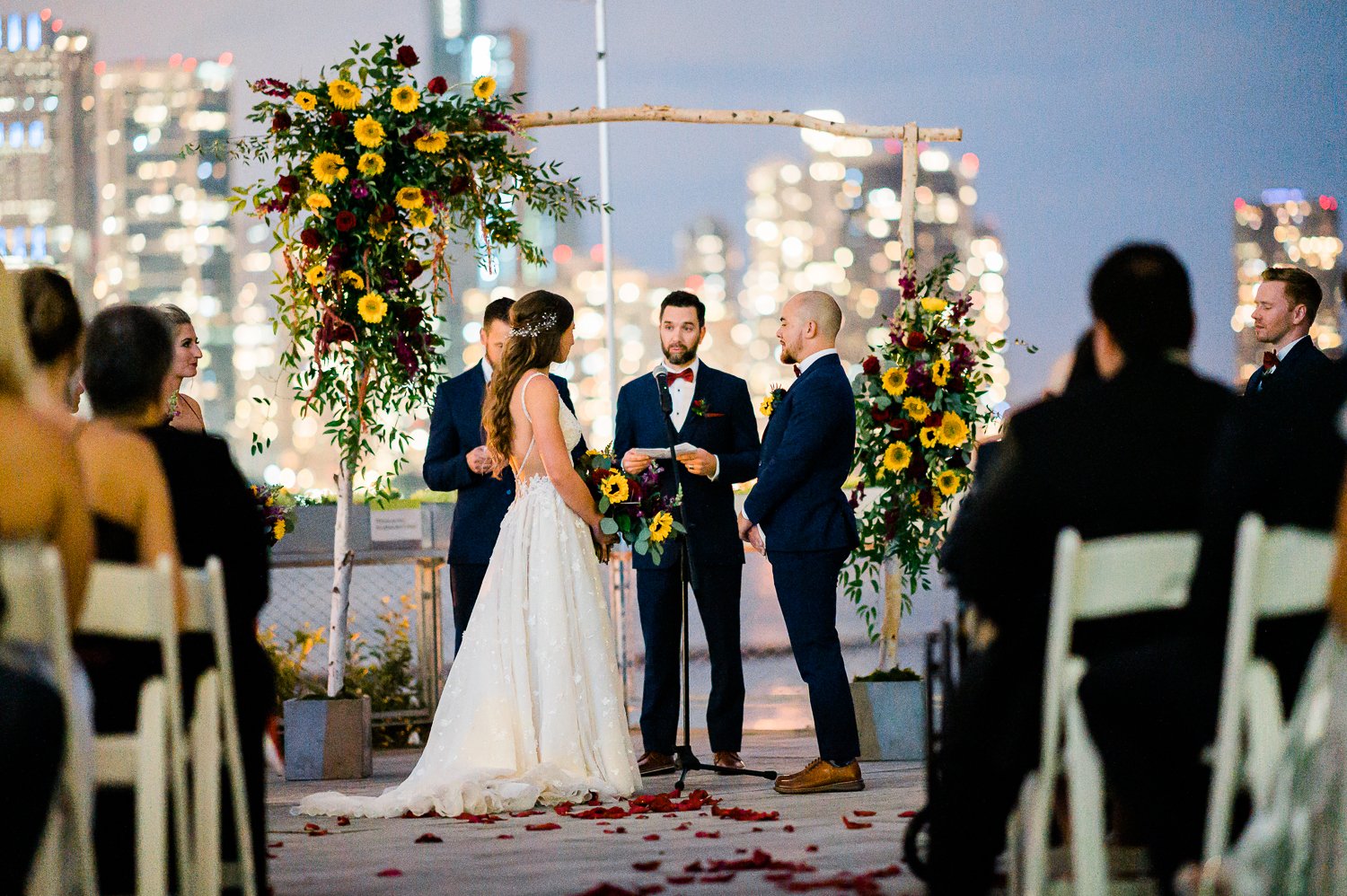
Photo Credit: Michael Nguyen | Michael Nguyen Photography | Best San Antonio Texas Wedding Photographer
Exchange of Rings: The exchange of rings is a symbol of the couple’s love and commitment to each other. The rings are placed on each other’s finger as a symbol of the love and commitment they have made to each other. The exchange of rings is a traditional and meaningful part of the wedding ceremony and can also be an opportunity for the couple to exchange personal vows or messages.
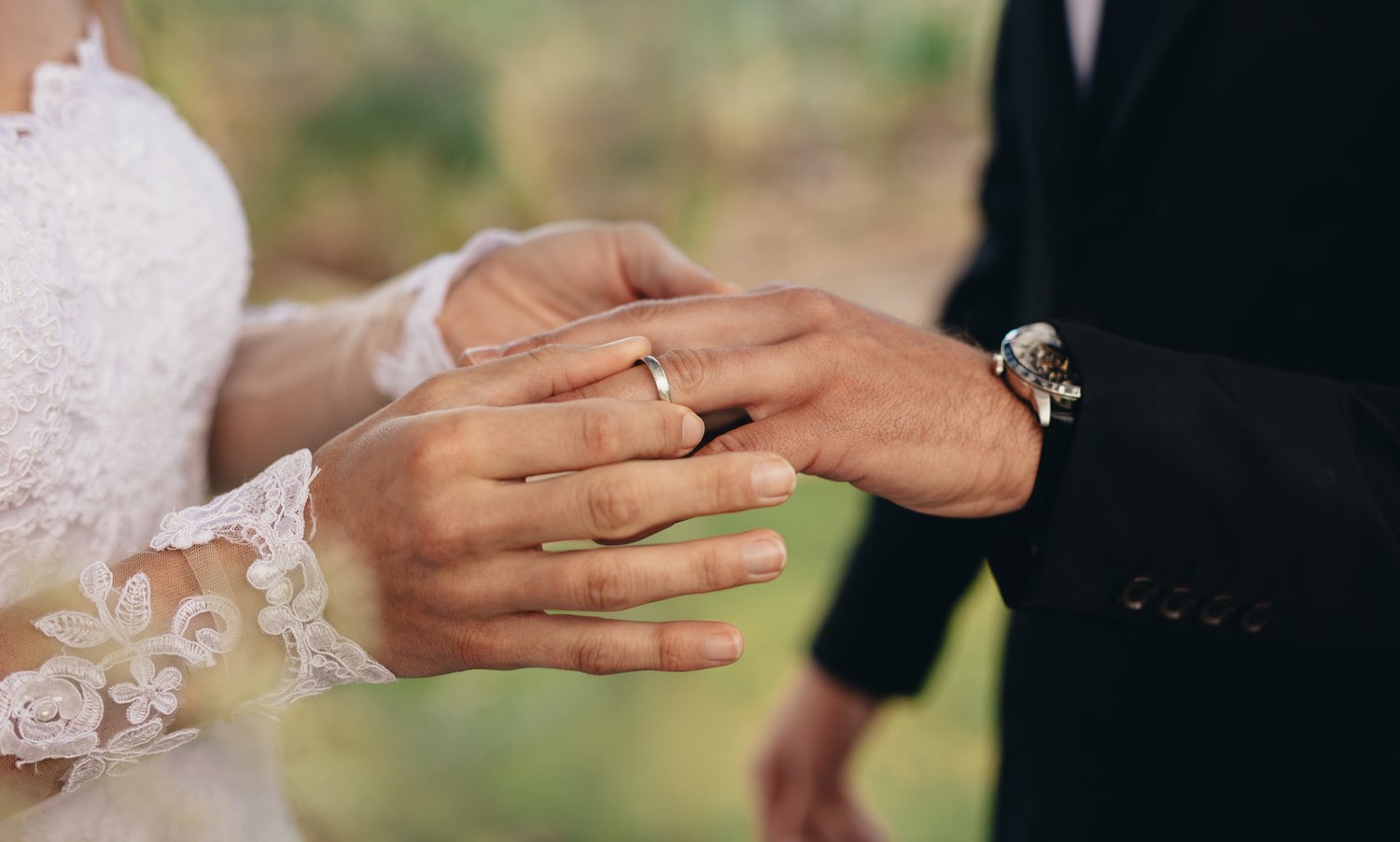
Closeup of bride putting a wedding ring onto the groom’s finger. Couple exchanging wedding rings.
Unity Ceremony: The unity ceremony is a symbolic act that represents the joining of two individuals into one. The couple can choose from a variety of unity ceremonies, such as a candle lighting, a sand ceremony, or a hand fasting ceremony. The unity ceremony is a way for the couple to symbolize their love and commitment to each other and make the wedding ceremony even more personal and meaningful.

Declaration of Marriage: The declaration of marriage marks the moment when the couple is pronounced husband and wife by the officiant or celebrant. This is a joyous and emotional moment and the culmination of all the planning and preparation that has gone into the wedding day. The declaration of marriage officially starts the couple’s life together and is a moment they will always cherish.
Kiss: THE BEST PART! The kiss is the first public act of affection as a married couple and is typically a sweet and romantic moment. The kiss marks the official start of the couple’s life together and is a symbol of the love and commitment they have made to each other. Psst! The photo below is me and my wife! Our first kiss as husband and wife.

Recessional: The recessional is the exit of the wedding party, including the bride and groom, bridesmaids, groomsmen, and other members of the wedding party. The couple typically leads the recessional, followed by the rest of the wedding party. The recessional music is usually more upbeat and celebratory and sets the tone for the rest of the wedding day.
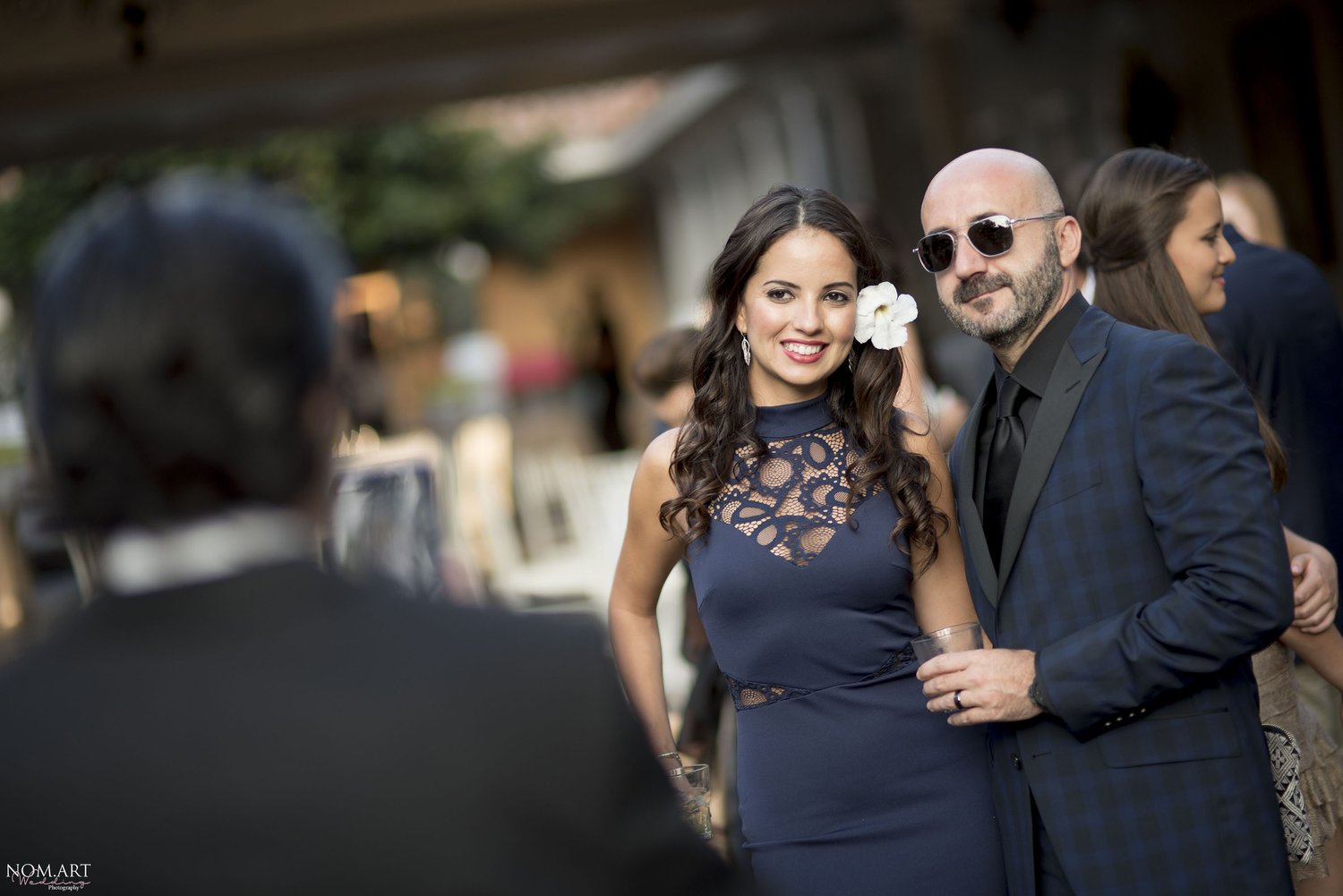
Postlude: The postlude is the period of music that is played after the ceremony and as the guests are exiting. This is a time for guests to reflect on the ceremony, talk to the couple and their families, and take in the beautiful memories they have just witnessed. The postlude music can be meaningful to the couple, such as classical pieces, contemporary songs, or even a special song that represents their relationship. The postlude provides a final touch to the wedding ceremony and helps to make the day even more memorable.
TOP SAN ANTONIO TEXAS WEDDING PHOTOGRAPHER FOR JEWISH WEDDINGS
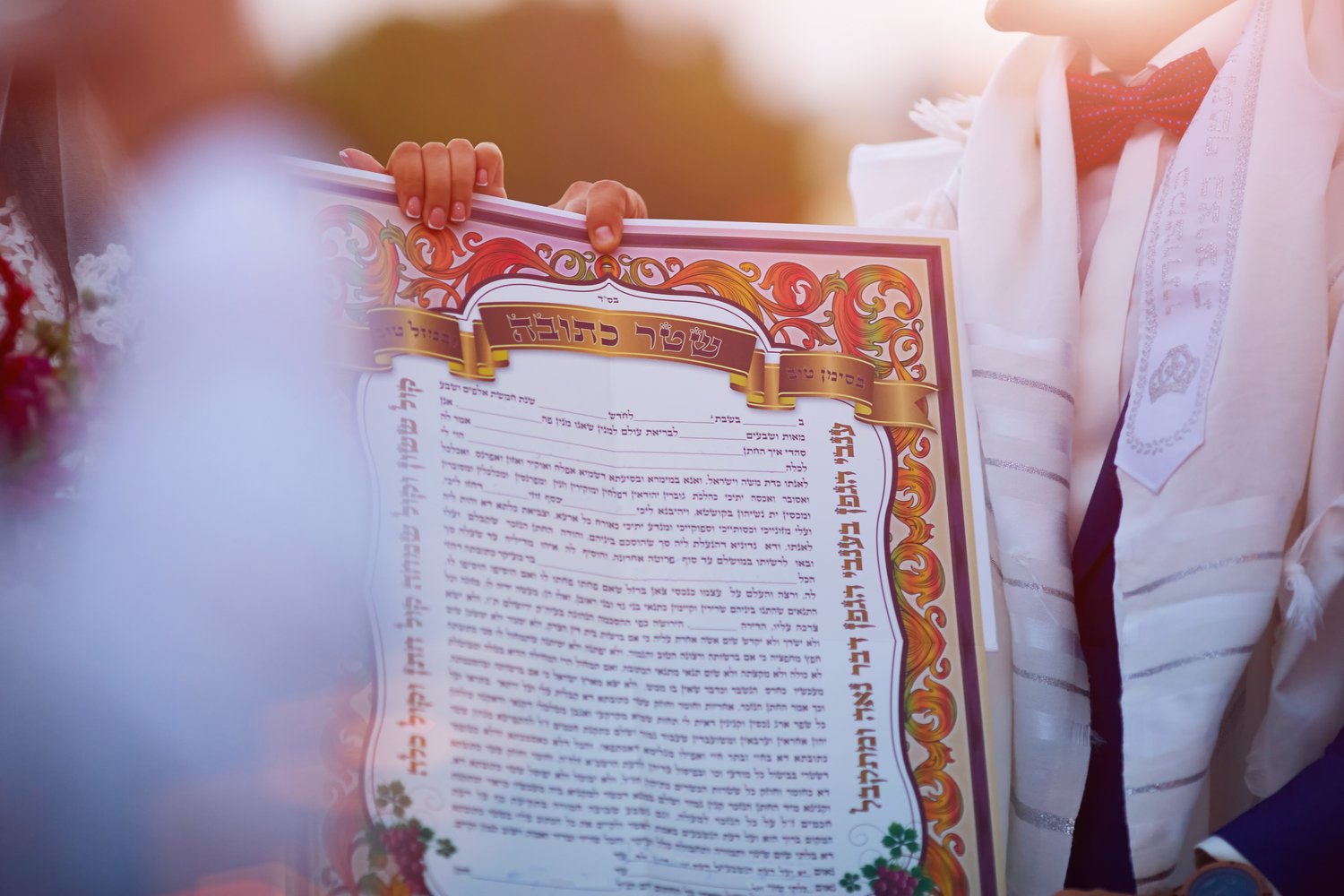
jewish groom signing a ketubah at his wedding.
In contrast to other traditions, Jewish marriages place the bride and her party to the right of the groom and his party. The shattering of glasses and the shouts of “mazel tov!” are two of the Jewish wedding’s most well-known traditions.
The processional at a Jewish wedding is called the “bedeken.” A veil is generally placed over the bride’s face at the bedeken, which occurs before the ceremony. The gesture represents the groom’s acceptance of the bride as his lifelong partner. The bedeken is a private moment shared only by the bride and groom. It is frequently followed by the wedding ceremony, during which the couple exchanges vows and is formally wed.
The vows and rings exchanged by the bride and husband during the wedding ceremony are referred to as the Vows Under the Chuppah. The Chuppah, a customary Jewish wedding canopy, represents the couple’s future home together. The bride and groom exchange rings and make commitments to one another during the Vows Under the Chuppah to symbolize their love and dedication to one another. In the Jewish wedding ritual, this is a crucial passage that represents the couple’s shared destiny.

Outdoor sunset view of a Jewish traditions wedding ceremony. Wedding canopy chuppah or huppah .
The bride rounds the groom seven times once you get to the chuppah, according to an Ashkenazi practice known as “circling.” It represents the bride erecting a barrier of defense around the groom. Usually, a blessing is said before you each sip wine from the same cup. In order to represent a more equitable sharing of roles, more contemporary couples circle each other three times each before doing so again.
This part is a bit tricky. The ring exchange portion in a Jewish wedding is an important part AND it can be a part of the Vows Under the Chuppah.If not, It can happen after the circling. During this portion, the bride and groom each place a wedding band on the other’s finger, symbolizing their commitment to each other and their love. In traditional Jewish weddings, the groom places the wedding band on the bride’s finger and recites a biblical verse in Hebrew, often “Harei at mekudeshet li b’taba’at zu k’dat Moshe V’Yisrael,” which translates to “Behold, you are consecrated to me with this ring according to the laws of Moses and Israel.” The bride then places a wedding band on the groom’s finger, completing the ring exchange and solidifying their commitment to each other.
Jewish wedding ceremonies include the Sheva Brachot, often known as the Seven Blessings, as a key component. The newlyweds, their families, or other designated leaders say a series of seven blessings while sipping wine. The Sheva Brachot pray for the bride and groom’s happiness and well-being and express joy and appreciation for their union. The blessings are intended to serve as a basis for the couple’s new life together and frequently draw inspiration from biblical tales of love and joy. Jewish wedding customs are not complete without the Sheva Brachot, which are a lovely way to commemorate the beginning of the couple’s life together.
After the wedding ceremony is over, the groom takes a glass and steps on it with his right foot, breaking it. The incident serves as a stark reminder of the frailty of life and the value of savoring each moment by serving as a metaphor for the fall of the Temple in Jerusalem. The breaking of the glass also represents the couple’s dedication to one another and the purity of their marriage. The couple and their guests then exclaim “Mazel Tov!” in jubilation at their marriage and the beginning of their lives together. For the bride and groom as well as their guests, the Breaking of the Glass is a joyful and significant aspect of the Jewish wedding ceremony. Ah, the crowd pleaser! After the glass is broken, guests are encouraged to yell “mazel tov!” to express their congratulations.
The recessional follows the joyful yells. Usually, as guests continue to applaud and wish them well, the wedding party marches back up the aisle in the reverse order that they entered. The newlyweds are at the head of the column, followed by the parents of the bride, the parents of the groom, the grandparents of the bride, and finally the grandparents of the groom. The bridesmaids and groomsmen follow the best man and lady of honor before the flower girls or ring bearers lead the remaining members of the bridal party. The filing is concluded by the rabbi or cantor.
PREMIER SAN ANTONIO WEDDING PHOTOGRAPHER FOR HINDU WEDDINGS
You probably already know that Hindu weddings are frequently lengthy, fanciful, and lavish affairs if you’ve ever attended one. I just attended the wedding of my good friends Nikita and Sid, and I as an enthusiastic San Antonio Texas wedding photographer wish it had lasted longer. Hindu weddings are typically extravagant affairs that last many days. Even if the wedding ceremony only occurs on one of the days, the celebrations and traditions that surround it last for several days. Please note, The ceremony order of a Hindu wedding may vary, but typically includes the following events:
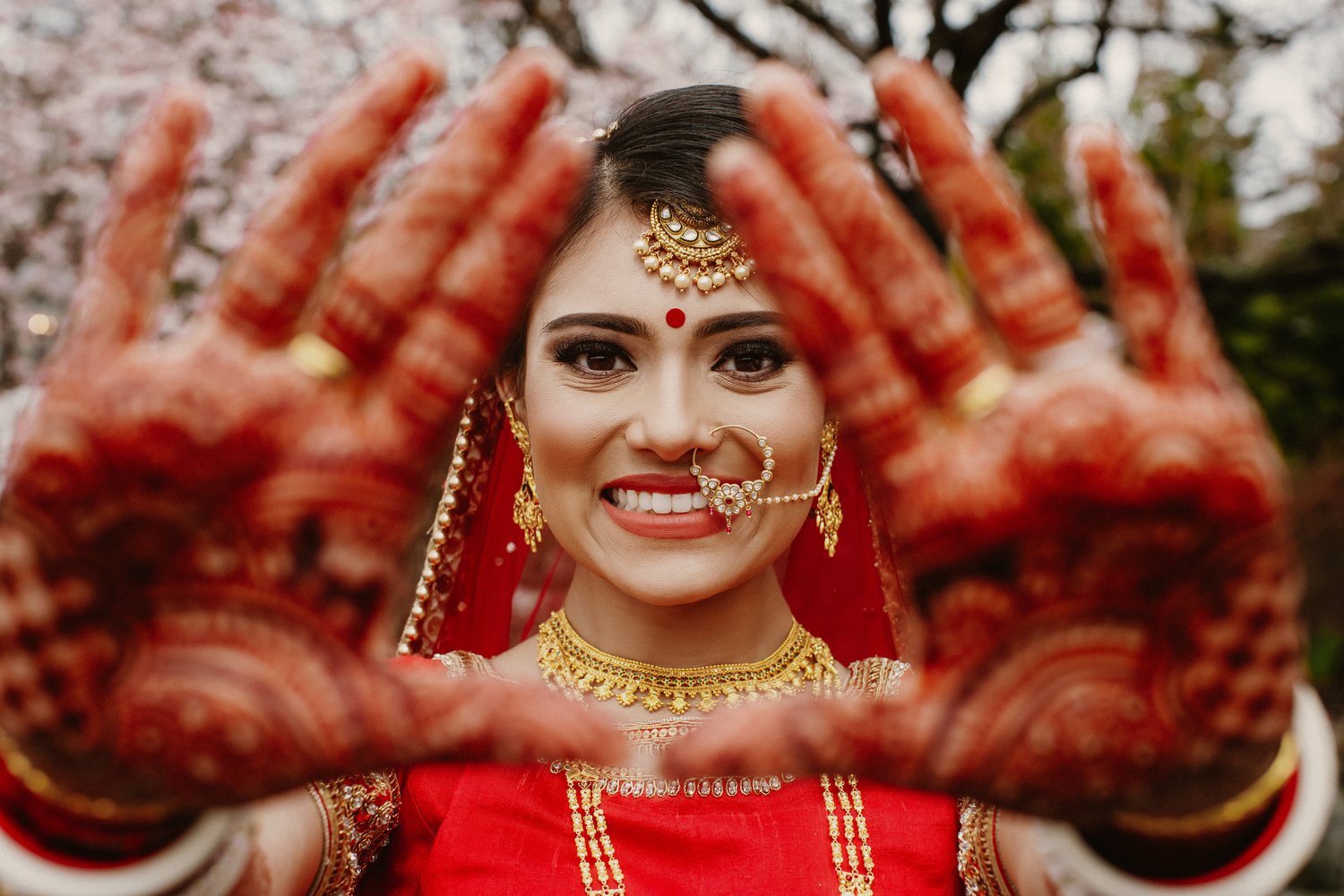
Portrait of a beautiful Indian bride in a traditional wedding dress
Ganesh Pooja: To guarantee that the wedding goes smoothly and successfully, a prayer is offered to Lord Ganesh, the Hindu god of fresh beginnings, to remove any obstructions. The priest typically offers flowers, fruits, and sweets to Lord Ganesh as part of this devotion.
Jaimala Ritual: The Jaimala ceremony involves the bride and groom exchanging flower garlands. This symbolic gesture denotes the couple’s togetherness and initiates the wedding ceremony. The seven steps of a happy marriage are symbolized by the seven vows the couple makes as they circle a holy fire.
Kanyadaan: In the Hindu wedding, the father of the bride offers her hand in marriage to the groom during the Kanyadaan ceremony. This deed represents the handover of the bride’s care from her father to her husband.
Saat Phere: During the Saat Phere ritual, the bride and groom take seven vows and seven steps. The couple’s dedication to one another and to the prosperity of their marriage is symbolized by the seven vows. The seven steps represent their shared path as they advance together.
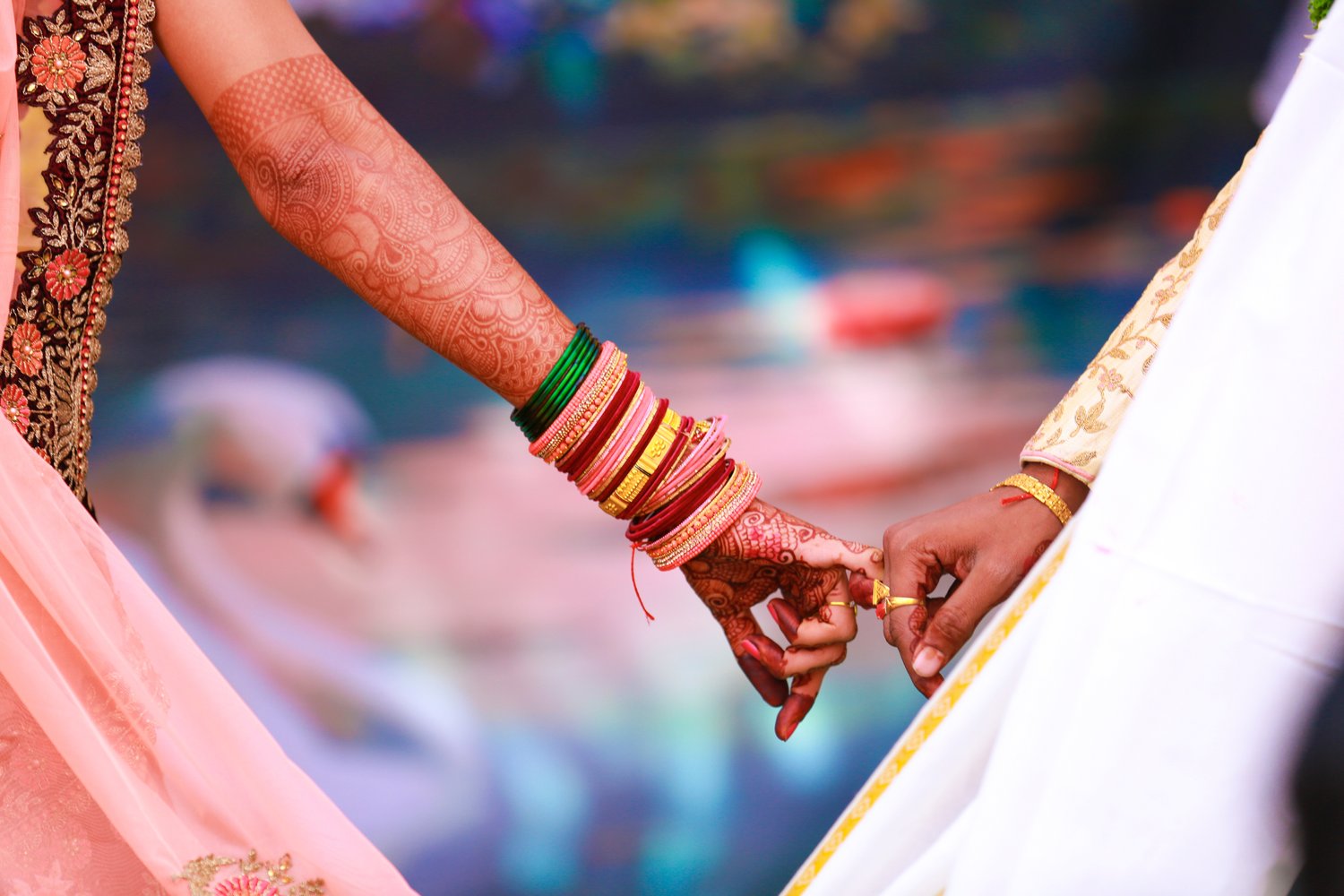
Indian couple hand in wedding Satphera ceremony in hinduism
Sindoor and Mangalsutra Ceremony: The marriage is officially concluded with the Sindoor and Mangalsutra ceremonies. The bride is covered with crimson powder called sindoor, and the husband fastens a mangalsutra around her neck. These actions serve as a depiction of the couple’s togetherness and marriage.
Haldi Ceremony: During the Haldi ceremony, turmeric paste is applied to the bride and groom in order to wish them luck and prosperity. This ritual is thought to protect the couple from bad spirits and get them ready for the big day.

Mehndi Ceremony: Henna is applied to the bride’s hands and feet during this pre-wedding festivity. The elaborate patterns are said to bring the couple luck, and the ceremony itself is a representation of love and happiness.
Sangeet Ceremony: A pre-wedding celebration featuring music, dance, and food is known as the sangeet ceremony. Families of the bride and groom gather to celebrate their union, and the bride and groom dance especially for each other.
Wedding Ceremony: The bride and groom exchange vows and wedding rings during the major Hindu wedding ceremony, which serves as the celebration’s focal point. During the ceremony, the couple goes around a holy fire seven times while exchanging seven vows and taking seven steps together.
Reception: The reception features food, music, and dancing as a way to celebrate the couple’s union. To salute the newlyweds, dance, and celebrate their delight, family and friends gather. The bride and groom make their first public appearance as a married couple at this happy occasion.

Front view of indian bride’s smile and traditional wedding accessories, hands colored with henna
Top SAN ANTONIO WEDDING PHOTOGRAPHER FOR CATHOLIC WEDDINGS
A Catholic wedding is a religious celebration of a man and a woman’s joining in marriage that is conducted by a Catholic priest. The ceremony is rooted in tradition and is based on the doctrine and rites of the Catholic Church. Prayers, Bible readings, hymns, the exchange of vows, and the passing of the rings are common elements of wedding ceremonies. The priest pronounces the couple married and they share a symbolic kiss to complete the union. The pair is required to live out their marriage vows in accordance with Catholic Church teachings because the wedding is regarded as a sacrament.
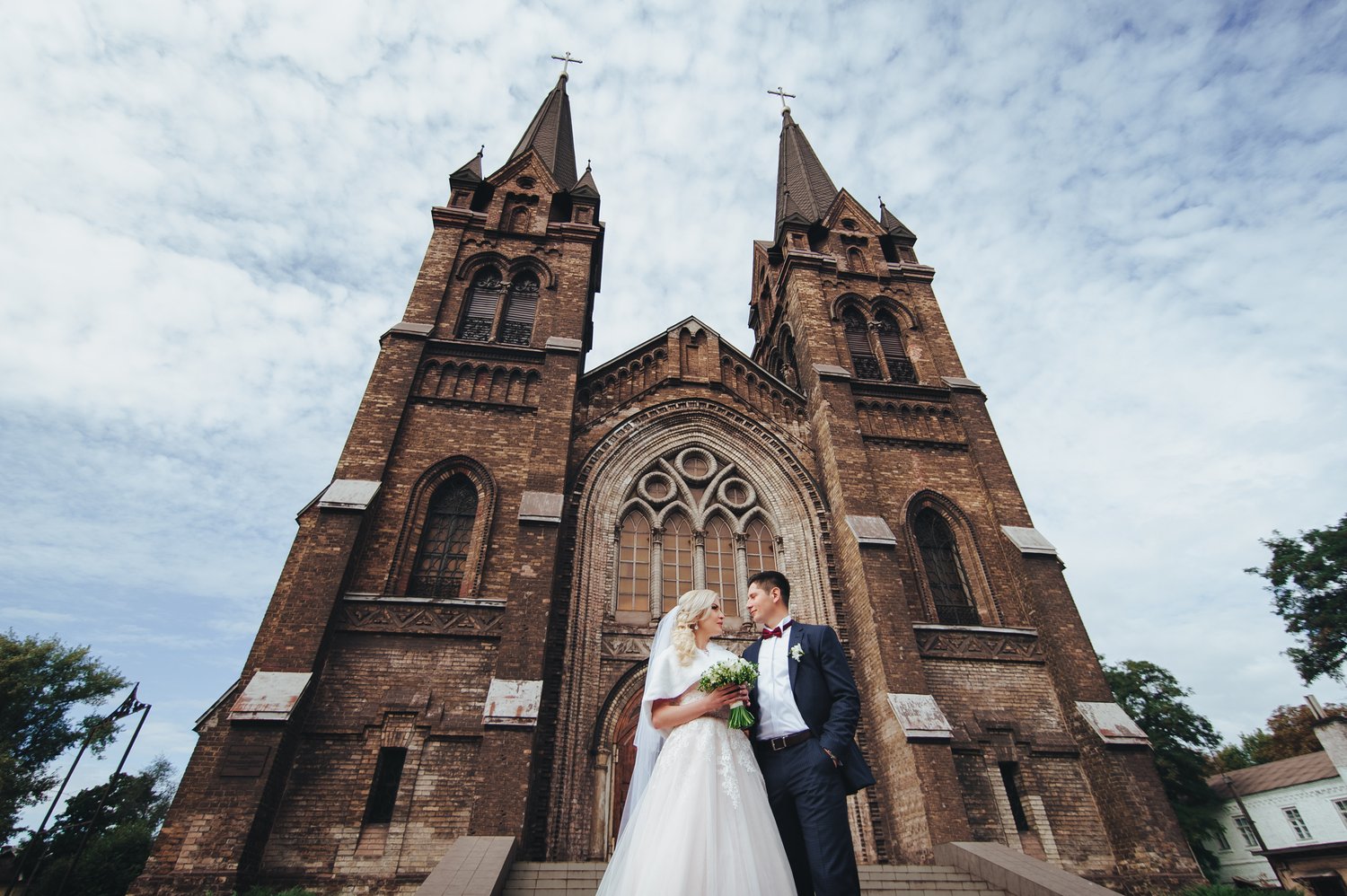
Photo Credit: Michael Nguyen | Michael Nguyen Photography | Best San Antonio Texas Wedding Photographer
Processional: The Catholic wedding ceremony officially commences with the processional. The bride and her bridal party enter the chapel and take their seats at the front, escorted by the bride’s father or another close family. At the altar, the groom and his groomsmen are waiting. The bride’s transition from her family to her future with her spouse is represented by this procession. The ceremony’s mood is defined by the music performed throughout the processional, which can be anything from the couple’s personal favorites to classic wedding music.
Opening Prayer: The priest or deacon will lead the Opening Prayer as a ceremonial greeting and introduction to the service. In their blessing, the priest or deacon may ask God to lead and strengthen the couple as they travel together.
Reading from the Old Testament: The reading from the Old Testament that is related to the themes of love, commitment, and marriage is chosen by the couple or the priest. During the ceremony, a friend or member of the wedding party will recite the passage aloud.
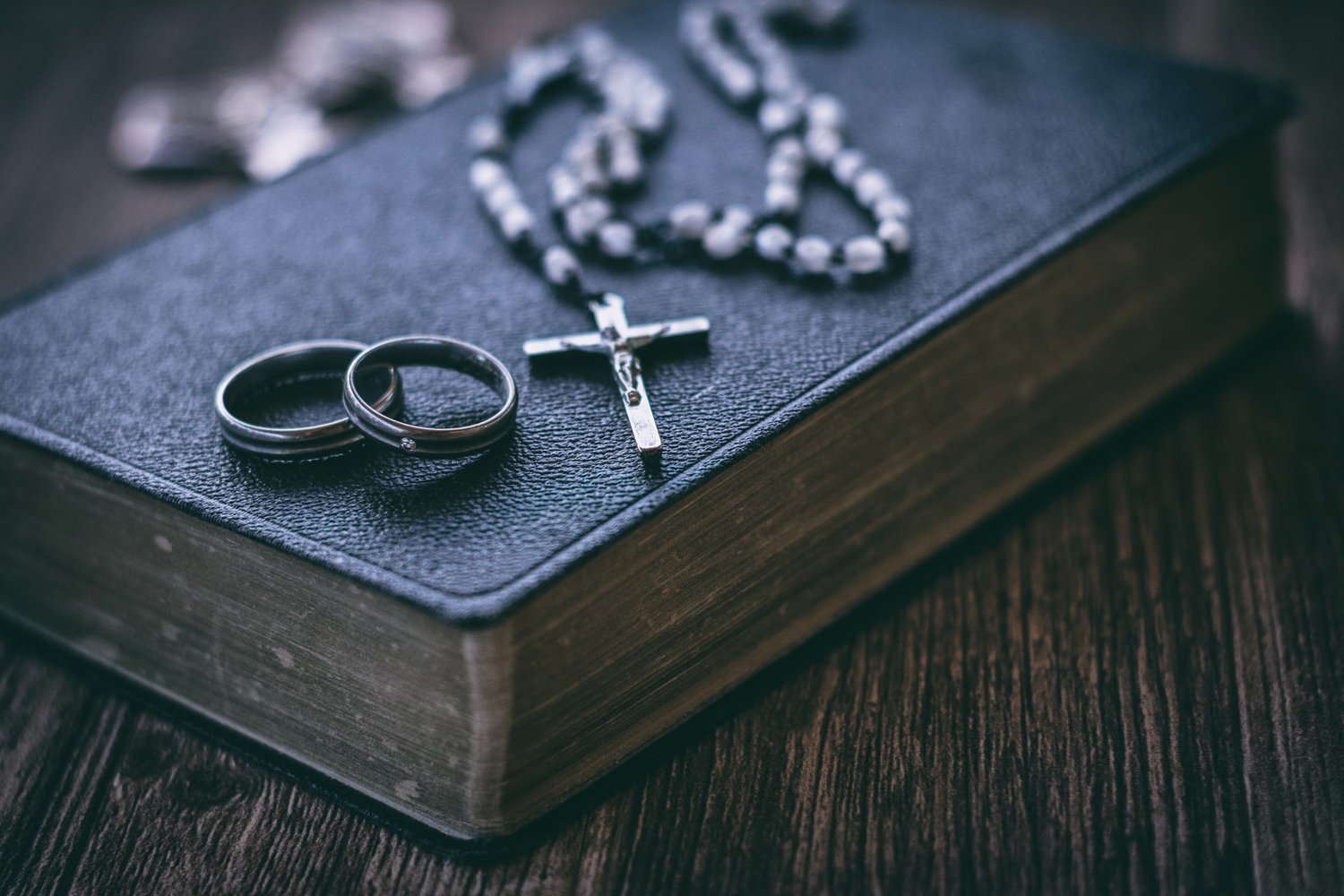
Responsorial Psalm: The congregation sings a hymn known as the Responsorial Psalm in response to the Old Testament reading. The psalm is chosen to go along with the Old Testament reading’s theme and to encourage and support the couple.
Reading from the New Testament: This reading, which is related to the themes of love, fidelity, and marriage, is also chosen by the couple or the priest. During the ceremony, a friend or member of the wedding party will recite the passage aloud.
Gospel Acclamation: The congregation sings this hymn in response to the reading from the New Testament. The hymn is chosen to support and encourage the couple while also tying in with the idea of the New Testament reading.
Homily: The priest or deacon delivers the homily, which is a reflection on the significance of marriage and the love between the couple. The priest or deacon might provide advice, insight, and encouragement to the couple as they begin their journey together during the homily.
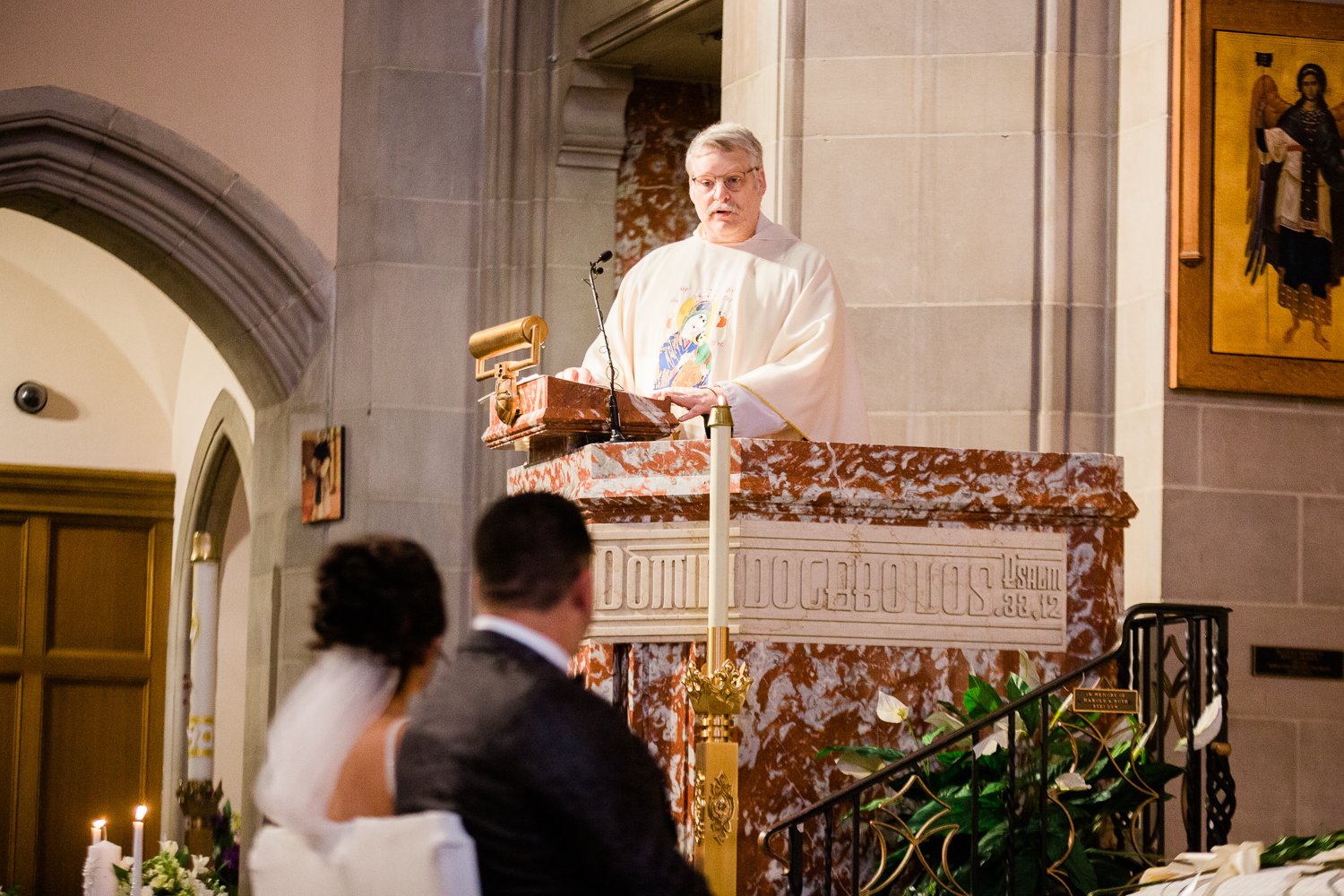
Photo Credit: Michael Nguyen | Michael Nguyen Photography | Best San Antonio Texas Wedding Photographer
Exchange of Vows: An important part of the Catholic wedding ritual is the exchanging of vows. The bride and groom exchange traditional or unique wedding vows, which serve as a declaration of their love and devotion to one another. A further indication of their union is the exchange of rings by the pair.
Prayers of the Faithful: The priest will lead a number of prayers known as the Prayers of the Faithful for the couple, their families, and the larger community. The pair uses the prayers as a means to seek God for help and direction as they embark on their journey together.
Nuptial Blessing: The Nuptial Blessing is a special blessing given by the priest to the couple during the Catholic wedding ceremony. The blessing is a way for the couple to seek God’s blessing and support on their journey together as a married couple.
Signing of the Register: The Signing of the Register is the legal recording of the Catholic wedding ceremony. The bride, groom, and witnesses sign the wedding register to officially acknowledge the marriage.
Communion: If desired, the bride and groom may participate in Communion with the congregation during the Catholic wedding ceremony. Communion is a way for the couple to symbolize their union with God and each other.

Sacrament of communion, Eucharist symbol
Recessional: The Recessional marks the end of the Catholic wedding ceremony. The bride and groom lead the procession out of the church, followed by the bridal party and guests. The music played during the recessional is usually upbeat and celebratory, reflecting
NONDENOMINATIONAL WEDDING
A wedding ceremony known as a nondenominational wedding is one that is not connected to a particular religious movement. It is a more individualized and secular occasion that emphasizes the couple and their love for one another. An officiant or celebrant who is not affiliated with any particular religious group usually officiates nondenominational weddings. Readings, prayers, music, and rituals can be chosen to reflect the couple’s beliefs and values, and the ceremony can be tailored to their tastes. Instead than following a religious tradition, the ceremony frequently focuses on the couple’s dedication to one another. Couples are increasingly choosing nondenominational weddings as a way to design a special and intimate celebration of their love.
The Processional: The bride and groom enter the ceremony area during the processional, joined by members of their wedding party and/or parents. The ceremony officially begins at this point, setting the tone for the remainder of the celebration. The procession is a unique occasion that frequently features music and marks the beginning of a new chapter in the couple’s lives.
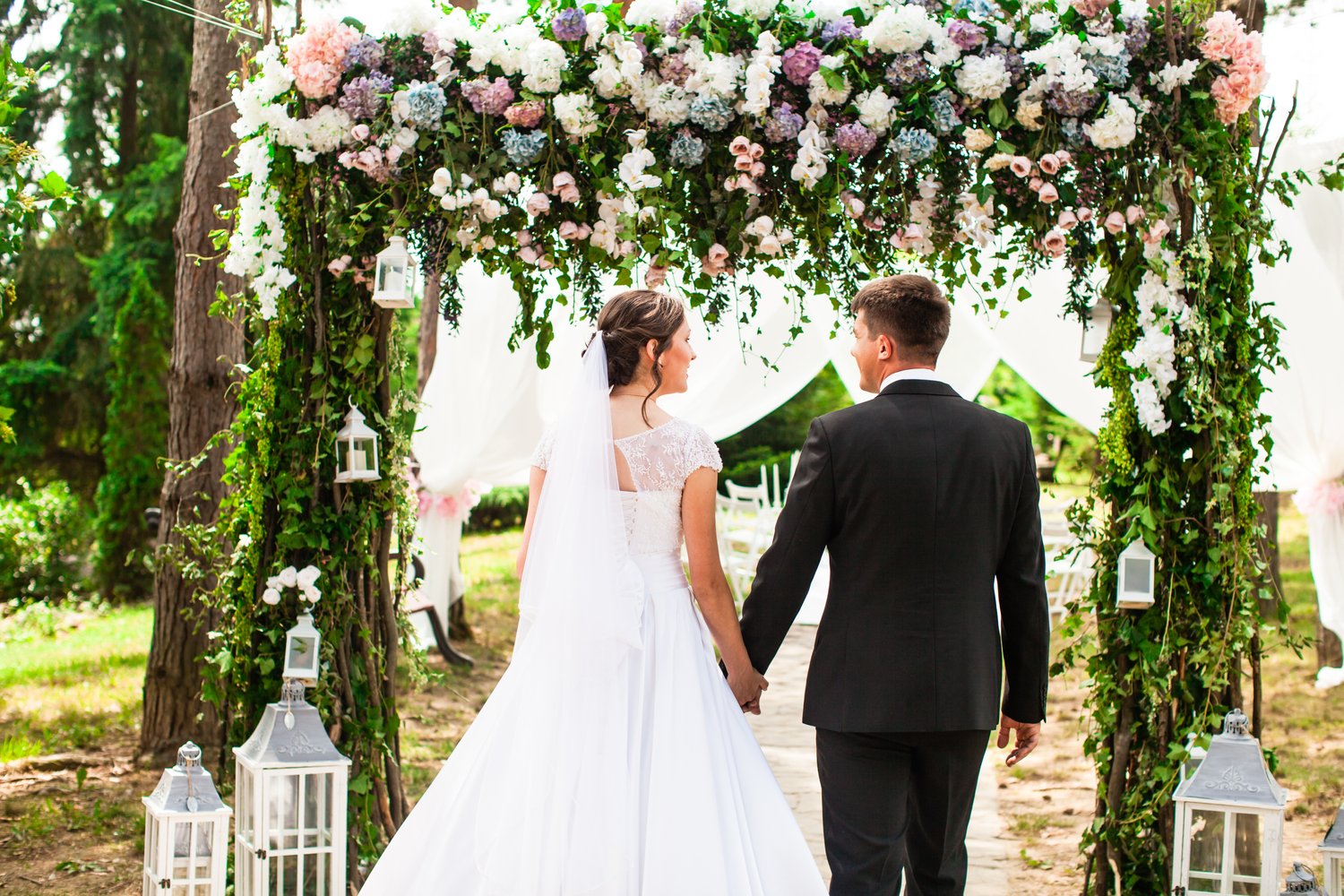
Beauty wedding couple under flower arch. Look from the back
Introduction: The celebrant or officiant extends a warm greeting to the visitors and gives them a quick rundown of the event. To establish the mood for the occasion, they might also say a prayer or share a reflection. The couple can express their personalities and ideals during the introduction, which also serves to set the tone for the rest of the ceremony.
Reading: The couple selects a book, poem, or other work of literature to reflect their union and morals. The couple and their guests may have a strong emotional connection as a result of this dramatic event. The reading, which can be delivered by the celebrant, a family member, or a friend, is frequently an important component of the service.
Personal Vows: The couple exchanges personal vows in which they declare their devotion to and love for one another. The couple can express their emotions and pledges to one another and their guests during this emotional and private moment. The pair might create their own personal vows or utilize standard vows as a starting point.
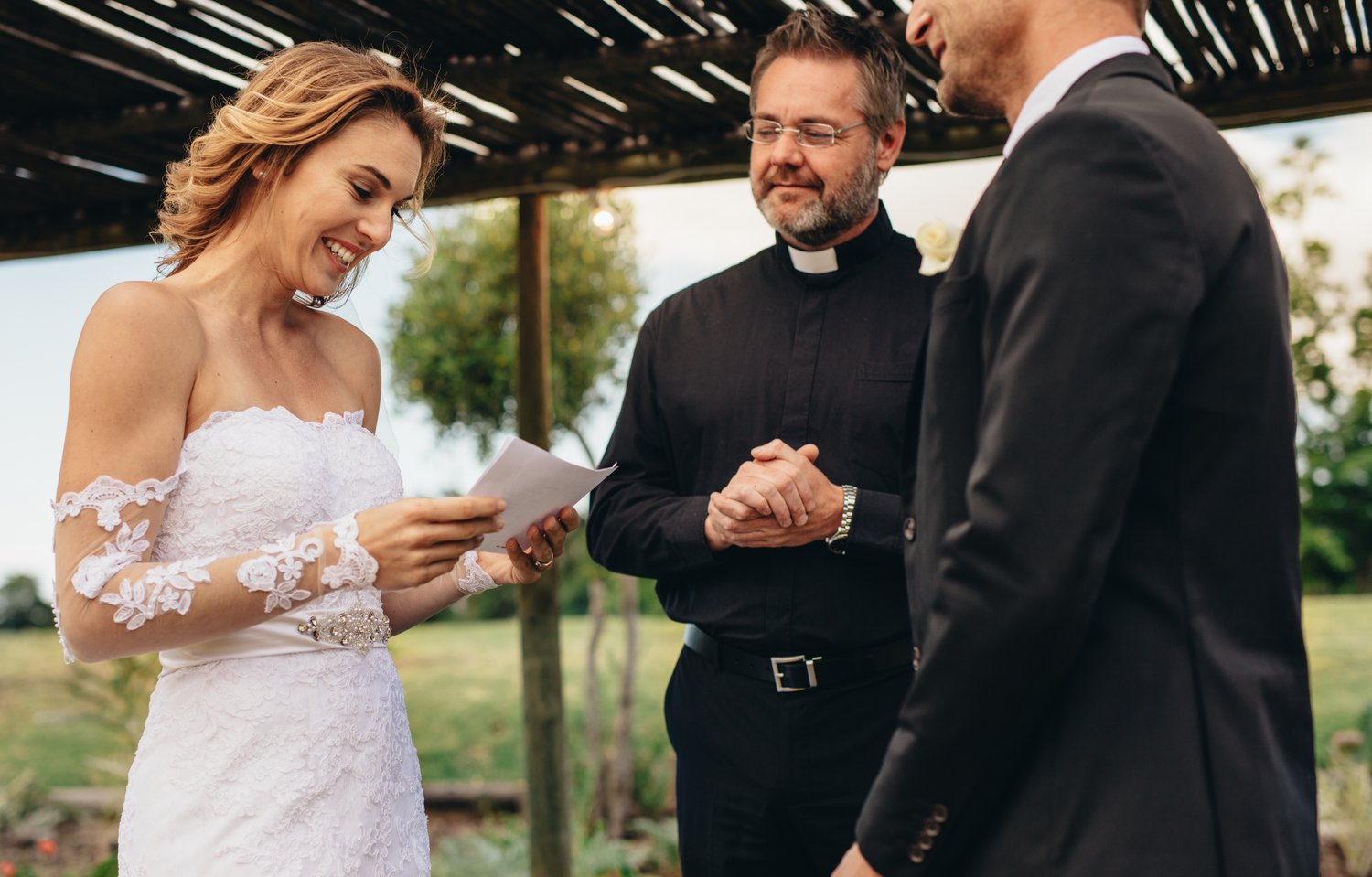
Woman read vows from paper for her husband at wedding ceremony background. Female partner reading marriage vows in ceremony with priest standing by.
Exchange of Rings: The exchanging of rings between the couple denotes their commitment to one another and their union. The ring exchange is a customary and significant aspect of the wedding ceremony that gives the couple a chance to publicly declare their devotion to one another. The rings are chosen to match the couple’s taste and personalities and might be plain or ornate.
Unity Ceremony: A symbolic action is carried out to represent the union of the couple, such as lighting a candle or pouring sand. The couple’s love and dedication to one another are expressed visually during the unity ceremony, which is a memorable event that will be cherished for years to come. The unity ceremony can be straightforward or ornate, and it is intended to showcase the personalities and ideals of the couple.
Pronouncement: The celebrant or officiant makes the couple legally married. This is the official announcement of the couple’s union, and people frequently applaud and cheer at this point. The announcement, which marks the ceremony’s conclusion, is a stirring and emotional occasion.
Kiss: The pair seals their marriage with a kiss. This happy and wonderful occasion signals the conclusion of the wedding and the beginning of the couple’s new life together. The couple’s love and dedication to one another are symbolized by the kiss, which is frequently one of the ceremony’s high points.
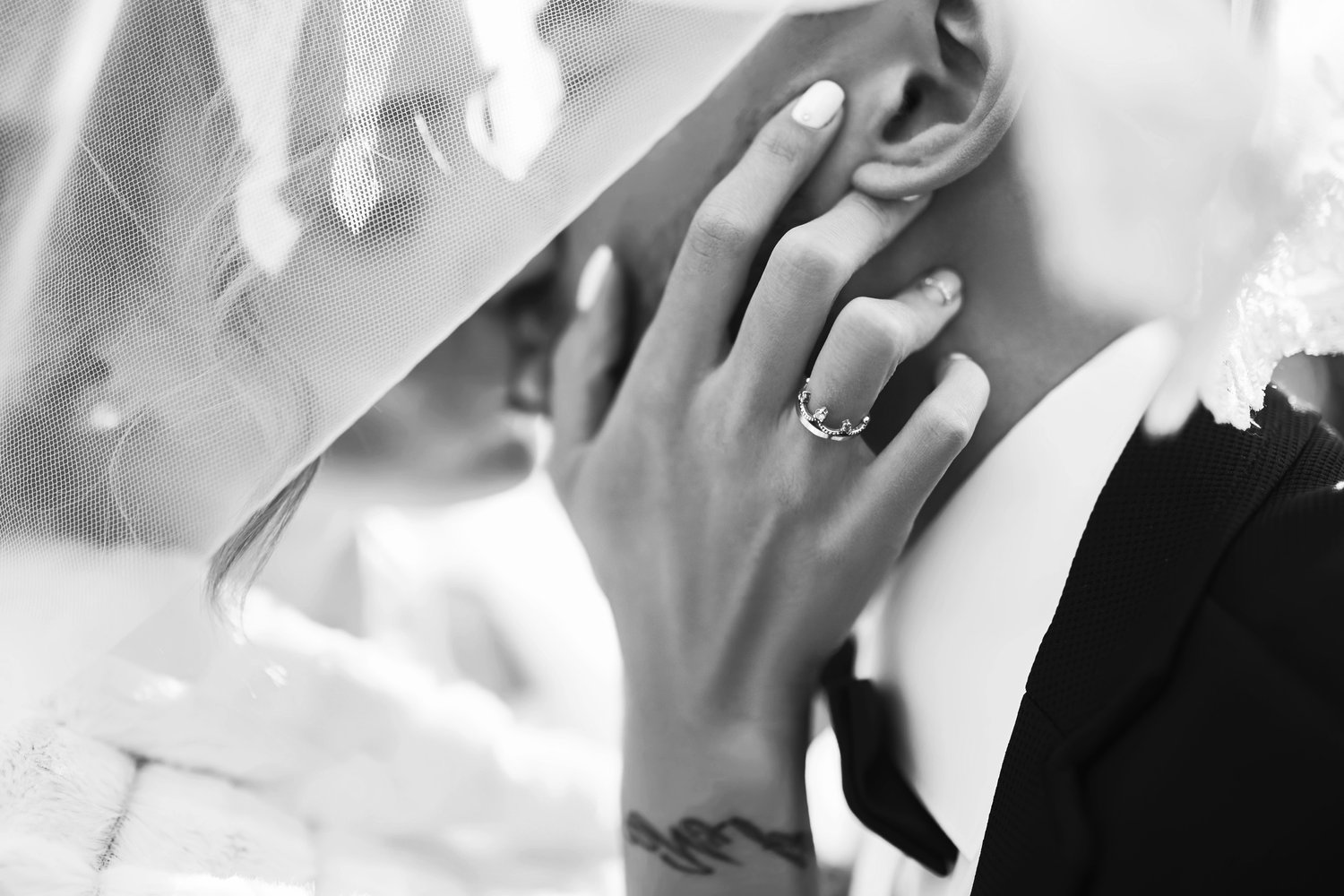
Recessional: The bride and groom leave the ceremony area, followed by any parents or members of their wedding party. The recessional is a time to celebrate the couple’s union, and it frequently includes music and applause. The recessional is a memorable part of the ceremony that marks the conclusion of the wedding and the beginning of the couple’s new life together.


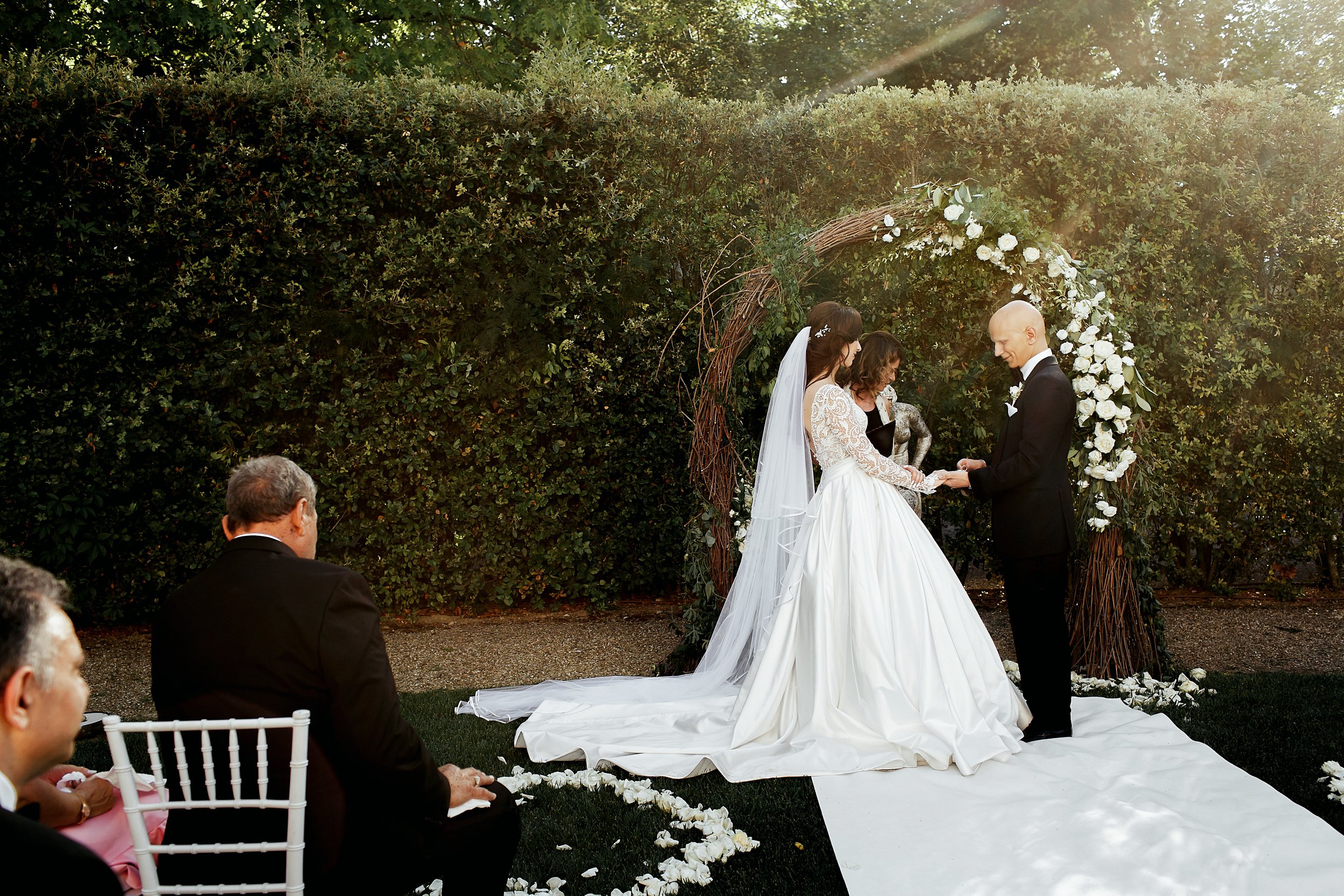
Join the discussion 6 Comments